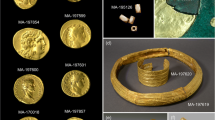Abstract
The problem of invisible gold has acquired global importance because, in many countries, large deposits of disseminated sulfide ores with refractory properties are the main potential source of gold production. The involvement of new gold sulfide deposits with refractory “invisible” gold in operation, in the authors' opinion, will increase and stabilize the level of gold mining in Russia until the end of the current century, because it is possible to extract annually 5–25 t of gold at each deposit for decades.
Similar content being viewed by others
References
N. V. Petrovskaya, Native Gold (Nedra, Moscow, 1973) [in Russian].
I. V. Vikent’ev, V. P. Moloshag, and M. A. Yudovskaya, “Speciation of noble metals and conditions of their concentration in massive sulfide ores of the Urals,” Geol. Ore Deposits 48 (2), 77–107 (2006).
G. V. Sedel’nikova, “Autoclave and bacterial leaching of refractory gold–sulfide ores and concentrates: Status and prospects of use in domestic industry,” in Proceedings of the International Meeting “Innovative Processes in the Complex and High-Level Processing of Mineral Raw Materials.” The Plaksin Readings. 2013 (Izd. TPU, Tomsk, 2013), pp. 28–33 [in Russian].
N. S. Bortnikov, L. Kabri, I. V. Vikentiev, et al., “Invisible gold in sulfides from seafloor massive sulfide edifices,” Geol. Ore Deposits 45 (3), 201–212 (2003).
A. D. Genkin, N. S. Bortnikov, L. Cabri, et al., “A multidisciplinary study of invisible gold in arsenopyrite from four mesothermal gold deposits in Siberia, Russian Federation,” Econ. Geol. 93, 463–487 (1998).
M. Reich, S. E. Kesler, S. Utsunomiya, et al., “Solubility of gold in arsenian pyrite,” Geochim. Cosmochim. Acta 69, 2781–2796 (2005).
V. V. Lodeishchikov, The Technology of Gold and Silver Recovery from Refractory Ores (Irgiredmet, Irkutsk, 1999) [in Russian].
V. I. Berger, D. L. Mosier, J. D. Bliss, et al., Sedimenthosted gold deposits of the world—Database and grade and tonnage models (ver. 1.1, June 2014): U.S. Geological Survey Open-File Report 2014–1074. http://dx.doi.org/10.3133/ofr20141074.
G. Yu. Akimov, A. V. Kryuchkov, T. L. Krylova, et al., “The Taryn vein-disseminated ore deposit: A new type of gold mineralization in the Verkhnyaya Indigirka region, Yakutia,” Dokl. Earth Sci. 397 (6), 737–742 (2004).
A. V. Volkov, A. A. Sidorov, V. I. Goncharov, et al., “Disseminated gold–sulfide deposits in the Russian Northeast,” Geol. Ore Deposits 44 (3), 159–174 (2002).
A. S. Radtke and B. J. Shaeiner, “Studies of hydrothermal gold deposition: Carlin gold deposit, Nevada: The role of carbonaceous material in gold deposition,” Econ. Geol. 65, 87–102 (1970).
J. D. Wells and T. E. Mullins, “Gold-bearing arsenian pyrite determined by microprobe analysis, Cortez and Carlin gold mines, Nevada,” Econ. Geol. 68, 187–201 (1973).
A. V. Volkov, “Disseminated gold–sulfide deposits in the Russian Northeast: Characteristics of the prospecting geological genetic model,” in Modern Problems of Ore Geology, Petrology, Mineralogy, and Geochemistry (IGEM RAN, Moscow, 2010), pp. 37–59 [in Russian].
Yu. I. Novozhilov and A. M. Gavrilov, Gold–Sulfide Deposits in Terrigenous Hydrocarbon Strata (TsNIGRI, Moscow, 1999) [in Russian].
A. V. Volkov and A. A. Sidorov, Chukotka’s Unique Gold Ore Region (SVKNII DVO RAN, Magadan, 2001) [in Russian].
J. R. Lang, T. Baker, C. J. Hart, et al., “An exploration model for intrusion related gold systems,” SEG Newsletter, No. 40, 6–15 (2000).
R. J. Goldfarb, R. Ayuso, M. L. Miller, et al., “The Late Cretaceous Donlin Creek gold deposit, Southwestern Alaska: Controls on epizonal ore formation,” Econ. Geol., No. 4, 643–671 (2004).
A. A. Sidorov, A. V. Volkov, and V. E. Glotov, “On the relationship between ore-controlling faults, Late Creta ceous sedimentary basins, and hydrocarbon shows,” Dokl. Earth Sci. 429A (9), 1435–1439 (2009).
A. B. Lazarev, A. V. Volkov, and A. A. Sidorov, “Orebearing duplexes at the Malomyr orogenic gold deposit, Amur region,” Geol. Ore Deposits 54 (6), 434–442 (2012).
V. A. Stepanov and V. G. Moiseenko, The Geology of Gold, Silver, and Mercury (Dal’nauka, Vladivostok, 1993) [in Russian].
J. S. Cline, A. H. Hofstra, J. L. Muntean, et al., “Carlin-type gold deposits in Nevada: Critical geologic characteristics and viable models,” Econ. Geol. 100, 451–484 (2005).
J. L. Muntean, J. S. Cline, A. C. Simon, et al., “Magmatic hydrothermal origin of Nevada’s Carlin-type gold deposits,” Nature Geosci. 4 (2), 122–127 (2011).
J. P. Richards, “Cumulative factors in the generation of giant calc-alkaline porphyry Cu deposits,” in Super Porphyry Copper and Gold Deposits: A Global Perspective, Vol. 1 (PGC Publishing, Linden Park, South Australia, 2005), pp. 7–25.
A. A. Sidorov and I. N. Tomson, “Ore-bearing in black shale masses: The convergence of alternative concepts,” Herald Russ. Acad. Sci. 70 (4), 375–379 (2000).
G. N. Gamyanin, N. S. Bortnikov, and V. V. Alpatov, Nezhdaninskoe Gold Ore Deposit As a Unique Deposit in the Russian Northeast (Geos, Moscow, 2000) [in Russian].
Author information
Authors and Affiliations
Corresponding author
Additional information
Original Russian Text © A.V. Volkov, A.A. Sidorov, 2017, published in Vestnik Rossiiskoi Akademii Nauk, 2017, Vol. 87, No. 1, pp. 40–49.
Aleksandr Vladimirovich Volkov, Dr. Sci. (Geol.–Mineral.), is Head of the Laboratory of the Geology of Ore Deposits, RAS Institute of the Geology of Ore Deposits, Petrography, Mineralogy, and Geochemistry (RAS IGEM). RAS Corresponding Member Anatolii Alekseevich Sidorov is Chief Researcher of RAS IGEM.
Rights and permissions
About this article
Cite this article
Volkov, A.V., Sidorov, A.A. Invisible gold. Her. Russ. Acad. Sci. 87, 40–48 (2017). https://doi.org/10.1134/S1019331617010051
Received:
Published:
Issue Date:
DOI: https://doi.org/10.1134/S1019331617010051




